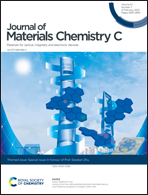Emerging materials for circularly polarized light detection†
Abstract
Detecting circularly polarized light (CPL) signals is the key technique in many advanced sensing technologies. Over recent decades, many efforts have been devoted to both the material design and the device engineering of CPL photodetectors. CPL detectors with different sensing wavelengths have distinct applications in bio-imaging, drug discovery, and information encryption. In this review, we first introduce the working principle of state-of-the-art CPL photodetectors followed by a general material design strategy. We then systematically summarize the recent progress on the chiral materials developed for CPL detection, including inorganic metamaterials, organics, hybridized materials, etc. We compare and analyse the photocurrent dissymmetry factors of these systems and provide perspectives on strategies to improve the dissymmetry factors and extend the detection wavelength. We believe that the information we include in this review would attract broader interest from researchers working on different aspects of organic and hybridized semiconductor materials and devices.

- This article is part of the themed collection: Special issue in honour of Daoben Zhu


 Please wait while we load your content...
Please wait while we load your content...